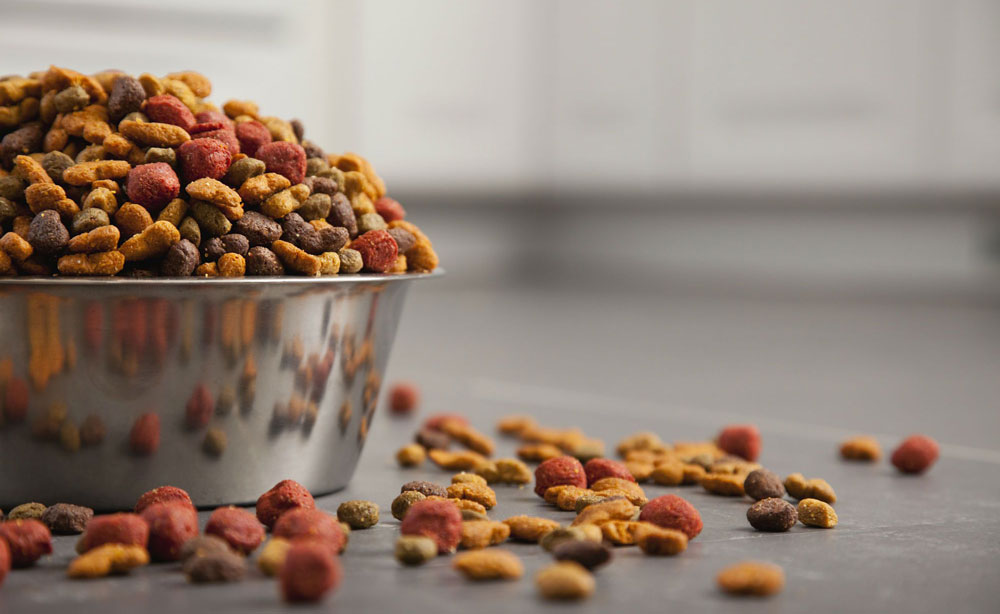If you go to any pet store or even to the local supermarket, you will see that there is an extensive selection of commercial diets available now. Pet owners spent $30 billion in pet food in 2018. Many companies want a piece of that market. This phenomenon makes choosing the perfect food for your cat or dog a very confusing task, with caring pet owners left to do research and reach conclusions regarding pet diets on their own. The problem is that many times the sources of the research are not the most accurate, and decisions are made based on internet pet food websites, blogs, trainer/groomer testimonials or the advice of the actual person selling you the diet. When choosing a diet for your pet, it is important to be skeptical of label claims, since many are marketing tools to distinguish the product from the other competing products in the market, and to persuade the pet owner into purchasing a more expensive product. Also, keep in mind that the ideal diet for one pet might not be ideal for another pet. So whether you’re looking into switching up your pet’s diet, or if you’re a new pet owner having just adopted a new pup or crested gecko for sale, be sure you’re doing thorough research to ensure you’re choosing the right diet for your animal. With all his in mind let’s review the most common market-driven pet diet fads:
Grains must be avoided. A common claim made by pet food companies is that grains (corn, soy and gluten -the protein in wheat) are detrimental to your pet. This is not correct. Only about 10 percent of the total population of pets with allergies are allergic to food. The clear majority are allergic to inhaled allergens. From the small population of pets with food allergies, the great majority are allergic to milk products and animal proteins (beef, chicken and fish being the most common allergy causing proteins). Corn and soy are in fact important sources of carbohydrates, and are also rich in vegetable protein. If wheat is avoided and replaced entirely by other carbohydrate sources, such a potato or tapioca, certain pets may experience gastrointestinal issues such as soft stool and excess gas due to a lack in the adequate fiber required for proper digestion. Neither dogs nor cats require a 100 percent protein diet. Dogs could survive on a vegetarian diet. Cats are obligated carnivores and must eat 30-40 percent of animal protein. Lastly, it should be pointed out that blood tests to diagnose food allergies are not accurate. For a diagnosis of food allergy, a food trial designed and closely supervised by a licensed veterinarian, performed over several months, is required. In addition to all these facts, in 2018 the Federal Food and Drug Administration (FDA) initiated an investigation on a potential link between heart disease in dogs and the consumption of grain-free pet food.
Stay away from GMOs. Over generations, plants and animals undergo spontaneous gene mutations (“natural modification”). Today, humans can manipulate the DNA of cells and modify crops and animals (“genetically modified organisms”). It is a controversial topic since, even though there are claims of adverse effects in humans and animals, those claims have not been validated. In fact, many inaccuracies have been found in the reports suggesting adverse effects. There are rigorous safety testing procedures a GMO product must pass before it reaches the market, including evaluation of the proteins for allergies and short/long term safety testing for the consumer, among other measurements. Benefits of GMOs are a reduction in soil erosion and resistance to pests, drought and disease. It is your decision as your pet’s advocate whether to avoid GMOs in the diet, however there is no evidence at this time that GMOs represent a threat to your dog or cat’s health.
Raw diets are healthier. The benefit of raw diets is controversial since there is no documented evidence that feeding a raw diet has any health or nutritional advantages over cooked foods. The selling point that canine and feline ancestors depended on raw diets and so it’s the “natural diet” is not a strong point, since our pet’s genetic make-up and lifestyle differs from those of their ancestors. Raw diets could potentially promote growth of pathogenic bacterial contaminants, which could lead to disease not only to the pet, but also to the owner handling the diet. If feeding a raw diet is your preference and your pet is doing well on it, continue feeding it. However, consider light cooking to kill any bacterial contaminants.
Each type of diet has advantages and disadvantages, and the price of the pet food does not always equate with the quality of the diet. With this in mind, when choosing a commercial diet look for a pet food company that has a long successful history in the industry, that has scientists with doctorate degrees in nutrition formulating the diets, that sources their own ingredients, and that makes their own food in their own factories under rigorous quality control testing. Look for a diet that your cat or dog likes and keeps them healthy, lean, and producing normal stool with no excess gas. Avoid pet food companies that outsource everything and just want to profit from the pet food market. Consult the one person that can give you sound professional medical and nutritional advice regarding your best friend: your veterinarian.
Dr Sanchez-Emden is the founder of the Animal Health and Rehab Center in South Miami. She has been practicing veterinary medicine for 25 years. As a Certified Veterinary Journalist, she is the resident veterinarian for Telemundo. She authored the book “CHIHUAHUAS: How To Be Your Dog’s Best Friend”. She also hosts the podcast show “Hablando de Perros y Gatos con Dr Marta” available at the main internet platforms. Follow her her blog, drmartavet.com, and on social media @Drmartavet on You Tube, Instagram and Twitter. Also find her at Facebook.com/dr.sanchezemden and animalhealthrehab.com










 Deering Estate
Deering Estate
 Massage Envy South Miami
Massage Envy South Miami
 Calla Blow Dry
Calla Blow Dry
 My Derma Clinic
My Derma Clinic
 Sushi Maki
Sushi Maki
 Sports Grill
Sports Grill
 The Healthy Kitchen
The Healthy Kitchen
 Golden Rule Seafood
Golden Rule Seafood
 Malanga Cuban Café
Malanga Cuban Café

 Kathleen Ballard
Kathleen Ballard
 Panter, Panter & Sampedro
Panter, Panter & Sampedro
 Vintage Liquors
Vintage Liquors
 The Dog from Ipanema
The Dog from Ipanema
 Rubinstein Family Chiropractic
Rubinstein Family Chiropractic
 Your Pet’s Best
Your Pet’s Best
 Indigo Republic
Indigo Republic




 ATR Luxury Homes
ATR Luxury Homes


 2112 Design Studio
2112 Design Studio
 Hamilton Fox & Company
Hamilton Fox & Company
 Creative Design Services
Creative Design Services
 Best Pest Professionals
Best Pest Professionals
 HD Tree Services
HD Tree Services
 Trinity Air Conditioning Company
Trinity Air Conditioning Company
 Cisca Construction & Development
Cisca Construction & Development
 Mosquito Joe
Mosquito Joe
 Cutler Bay Solar Solutions
Cutler Bay Solar Solutions


 Miami Royal Ballet & Dance
Miami Royal Ballet & Dance
 Christopher Columbus
Christopher Columbus
 Pineview Preschools
Pineview Preschools
 Westminster
Westminster
 Carrollton
Carrollton
 Lil’ Jungle
Lil’ Jungle
 Frost Science Museum
Frost Science Museum
 Palmer Trinity School
Palmer Trinity School
 South Florida Music
South Florida Music
 Pinecrest Orthodontics
Pinecrest Orthodontics
 Dr. Bob Pediatric Dentist
Dr. Bob Pediatric Dentist
 d.pediatrics
d.pediatrics
 South Miami Women’s Health
South Miami Women’s Health

 The Spot Barbershop
The Spot Barbershop
 My Derma Clinic
My Derma Clinic




 Miami Dance Project
Miami Dance Project

 Rubinstein Family Chiropractic
Rubinstein Family Chiropractic
 Indigo Republic
Indigo Republic

 Safes Universe
Safes Universe
 Vintage Liquors
Vintage Liquors
 Evenings Delight
Evenings Delight





 Atchana’s Homegrown Thai
Atchana’s Homegrown Thai
 Baptist Health South Florida
Baptist Health South Florida

 Laser Eye Center of Miami
Laser Eye Center of Miami
 Visiting Angels
Visiting Angels
 OpusCare of South Florida
OpusCare of South Florida

 Your Pet’s Best
Your Pet’s Best





 HD Tree Services
HD Tree Services
 Hamilton Fox & Company
Hamilton Fox & Company


 Creative Design Services
Creative Design Services